#KeystoneCorrection
Explore tagged Tumblr posts
Text
Ultra-Short Throw ViewSonic PX800HD projector Review

ViewSonic PX800HD for two years is one of the best ultra short throw (UST) home theater projectors on the market. Relatively affordable price, high dinamic contrast (100,000: 1), innovative RGBRGB color wheel, ultra throw ratio 0.23: 1 (D: W), very quick 16 ms input lag, 1080p, Full 3D and 2000 ANSI lm provide its high competitiveness in the segment of UST home theater projectors, including gaming. The model uses the traditional design of UST projectors with a semi-enclosed recess for the reflective mirror.

An optional BrilliantColorPanel achieves a contrast ratio 4-times higher than that of an average projector screen.

Of course, ViewSonic PX800HD supports Imaging Systems Foundation (ISF). But, ISF-calibration requires additional costs.

Besides, the projector practically does not create the rainbow effect, which is traditional for DLP technology. Unfortunately, the fan noise level reaches 35 dB in the Normal mode, that is perceived even at a some distance from the projector. But it decreases to 29 dB in Eco mode. Additionally, this projector uses SonicExpert technology that includes an enlarged speaker chamber and a more powerful amplifier to deliver a full 20Hz - 20Khz sound range.

Like all ViewSonic projectors, the PX800HD has PortAll MHL / HDMI port.

Moreover, model supports playback 3D images directly from 3D Blu-ray players. 3D images can be viewed with optional ViewSonic PGD-350 Shutter Glasses, or any other compatible 3D glasses.

Brightness
Eco and Normal levels provide the following brightness in modes: - Brightest – 1637/1140 ANSI lm (Normal/Eco); - Dynamic – 1375/957; - Standard - 1175/818; - Movie - 1077/750; - Rec. 709 - 897/624. Eco mode reduces lamp power by 30%. At the same time, SuperEco uses an auto power saving. Dynamic mode works like auto iris. This mode reduces the lamp brightness in dark scenes. 1375 lm provides an acceptable image quality for a 100" screen even in room with scattered daylight. Of course, the market offers quite a lot of similar models with greater brightness. Accordingly, they do not require careful darkening. But the PX800HD with a dinamic contrast ratio of 100,000: 1 and a brightness of 2000 lm competes quite successfully with them due to optimization of black, good color saturation and wide dynamic range. In particular, it provides a sufficiently high quality on the screen up to 100" even in daylight. Of course, this is an exellent result for the UST projector. The brightness uniformity reaches only 75%. Of course, it's ok for UST models, but inferior to traditional projectors for home theaters. On the other hand, this difference can be seen only next to the test image of the 100 IRE. Moreover, this factor practically does not interfere when watching a video. But factory presets for Brightest, Dynamic, Standard, Movie and Rec709 modes close to optimal. Unfortunately, ViewSonic PX800HD does not offer custom modes. But model has manual adjustment of contrast, brightness and color temperature. As known, RGBRGB color wheel provides exellent color brightness due to absence of a white. segment.

In addition, a RGBRGB color wheel delivers Rec. 709 color accuracy.

Features
As known, all UST models, including ViewSonic PX800HD, require alignment, image adjustment and focusing when installed after any its movement. But model has horizontal and vertical Keystone correction and 4-corners adjustment, that drastically simplifies this task. Digital Keystone provides ± 30° horizontally, and + 30°/-12° vertically.

Additionally, Four Corner Adjustment eliminates warping, creating an image with perfect proportions.

The lensing system uses a mirror to reflect the image through a window near the back of the projector. Throw distance varies in range of 14.5 - 31.4 inches for a diagonal image size of 70" to 150" (100"@5,9 ft).

Input lag does not exceed 33 ms. But 3X Fast Input option reduces it to an unprecedented 16 ms.

Additionally, ViewSonic's Cinema Supercolor technology optimizes cinematic color scenarios, including optional or analog color schemes.

PROS & CONS
Pros - excellent image quality; - RGBRGB color wheel; - Cinema Supercolor technology; - SonicExpert technology; - ISF-calibration support; - input lag of 16 ms with 3X Fast Input option; - high contrast; - 100"@5,9 ft; - horizontal and vertical Keystone correction and 4-corners adjustment; - high quality factory presets; - protected PortAll MHL / HDMI port; - 3 year warranty. Cons - very high fan noise level; - model requires careful alignment at installation; - no Frame Interpolation; - no custom modes; - inconvenient access to ports. All ports are on the front of the PX800HD, facing the wall. Accordingly, access to them requires the rotation of the projector and its subsequent adjustment. Of course, all these factors affect the choice of the optimal projector. This video illustrates the great opportunities of ViewSonic PX800HD projector. Read the full article
#3XFastInput#4-cornersadjustment#BrilliantColorPanel#CinemaSupercolortechnology#FourCornerAdjustment#ISFcalibration#KeystoneCorrection#PGD-350ShutterGlasses#PortAllMHL/HDMIport#RGBRGBcolorwheel#SonicExperttechnology#Ultra-ShortThrowViewSonicPX800HDprojector
0 notes
Text
3LCD Epson Home Cinema 3700 projector Review

In fact, the 3LCD Epson Home Cinema 3700 (EH-TW6700 in Europe) began a continuation of a series of low-cost models for home theater and home entertainment. As known, in 2015, Epson introduced Epson Home Cinema 2040/2045 (1920x1080, 2200 ANSI lm) and 740HD (1280x720, 3000 ANSI lm) projectors are all priced well under $ 1,000. Then, in 2017, the company expanded this series with 3100/3700 models. The Epson 3700 costs $ 200 more compared to 3100 and has a built-in speaker. Both models have almost identical specs and design.

Compared with previous Epson 2040/2045, Epson 3700 provides higher brightness, better contrast and color accuracy, an increased zoom range (1.6x instead of 1.2x), and an extended vertical / horizontal lens shift range. In addition, it supports advanced features, including Super Resolution mode, gamma adjustment, picture-in-picture mode, and manual adjustment of the convergence of three chips. In fact, this set of functions corresponds to the functionality of Epson 3900. But the Epson 3900 costs $ 500 more. Of course, this factor significantly affects the choice of the projector. Projector supports 2D to 3D conversion and two color modes in 3D. One mode provides a higher brightness, but has a slight green bias. The other mode provides more natural colors, but with a lower brightness. For comparison, many models of this price segment have only maximum brightness by default for loss compensation in 3D glasses. The stereoscopic image uses the frame interleaving mode. Model supports any RF glasses. Additionally, model has a VGA input and two HDMI inputs, one of which supports an MHL connection. The USB port (type A) provides connectivity for external media and an optional Wi-Fi adapter.
Epson Home Cinema 3700
Projector provides dynamic contrast ratio of 70,000: 1 (full on/off) without auto iris and darkening using software algorithms. In fact, such a contrast corresponds to level of the DLP projectors of this price segment. But, of course, without the traditional for the DLP technology, the rainbow effect. Model brightness reaches of 3000 ANSI lm. It provides a high-quality image even in a room with scattered daylight and the excellent 3D image quality, despite the brightness loss due to 3D glasses. The projector has two built-in stereo speakers of 10 W.

As know, Epson 3700 has a Throw Ratio of 1.34: 1 - 2.17: 1 (D:W). Its throw distance ranges from 6,2 to 17 ft, and image size from 40" to 180". Projector provides 100" diagonal screen at distance of lens between 9,5 and 16 ft.

Projector has a good 1.6: 1 zoom and convenient manual lens shift adjustment, which reaches of ±24% and ±60% horizontal & vertical, respectively. Keystone Correction reaches of ±30 degrees (Auto) and ±30 degrees (Slide bar) horizontal & vertical, respectively. Epson Image Enhancement Technology (Super Resolution Technology) visually increases the image detail and is designed for high-quality content (for example, from Blu-ray discs).

Additionally, the frame interpolation function provides a 60 fps effect for content with 24 fps and improves the playback quality of highly dynamic scenes.
Features, Pros & Cons
Projector uses Epson 3LCD 3-chip technology, Epson Polysilicon TFT Active Matrix, 0.61- inch wide panel with MLA. The color saturation and black level provide a sufficiently high image quality. Epson Home Cinema 3700 has 4 preset color modes, including Dynamic, Bright cinema, Natural and Cinema. The range of brightness values for different modes (High, Medium and Eco) varies from 2306 to 3438 for Dynamic, from 1653 to 2465 for Bright cinema, from 1736 to 2588 for Medium and from 1635 to 2439 for Eco. Bright Cinema mode provides fairly accurate color rendering on a 225" screen in a darkened room or on a 140" screen with moderate lighting. Dynamic mode is well suited for presentations, providing an acceptable quality at a maximum brightness of 3700 lm. Lens in the long focus reduces the brightness by only 8% compared to the wide-angle mode. The brightness uniformity reaches of 86%. Of course, the color brightness corresponds to the brightness of the white due to use of 3LCD technology. Unfortunately, Input lag is 28 ms without frame interpolation, but reaches 105 when on. Pros - very good picture quality; - remote control with backlight; - high contrast; - two color modes for 3D; - two built-in stereo speakers of 10 W; - zoom of 1.6: 1; - very low brightness reduction in the long-focal position of the lens; - two HDMI inputs (including MHL); - support of Picture-in-Picture, Full HD 3D, Geometric Correction and Frame Interpolation. Cons - relatively high noise level; - delay in automatic iris control; - noise during Auto Iris work; - very high Input lag with Frame Interpolation; - both color modes in 3D have drawbacks (distortion of color rendering or insufficient brightness); - the controversial placement of speakers on back panel. This video illustrates a very high image quality directly on the beige wall without a screen. Read the full article
#3LCDEpsonHomeCinema3700projector#EpsonEH-TW6700#EpsonHomeCinema2040#EpsonHomeCinema2045#EpsonHomeCinema3100#EpsonHomeCinema740HD#EpsonImageEnhancementTechnology#EpsonPolysiliconTFTActiveMatrix#FrameInterpolation#GeometricCorrection#KeystoneCorrection#Picture-in-Picture#SuperResolutionTechnology
0 notes
Text
Anker Nebula portable projectors Review
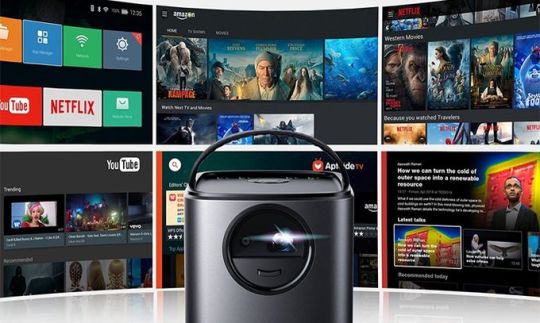
Traditionally, projectors use powerful lamps as a light source. But they have several significant drawbacks, the list of which includes limited Lamp Life, their high cost and high heat transfer. As a result, these models require a large internal volume for heat dissipation and a powerful fan with a high noise level. In addition, high power consumption significantly limits the ability to use the battery. The rapid development of semiconductors radically changed the situation. As known, LEDs and laser LEDs practically do not heat up, and their service life reaches 30,000 hours, which corresponds to more than 10 years. These factors were ideal for use LEDs as light sources in projectors. New compact light sources have led to the emergence of the LED projectors. Wherein, compactness has become one of the main directions of their improvement. Such models are often called pico projectors. But many companies often use the terms mini, pocket or portable. Of course, consumers have responded enthusiastically on the new offer. As a result, many well-known companies, including Sony, Miroir USA, LLC, Optoma, AAXA Technologies Inc., etc expanded the range of their traditional lamp projectors. But besides them, many new companies, including Rif6, LLC, Apeman International Co, etc also started developing Pico projectors. In addition, the modern market offers smartphones with projector functions. As known, Anker is the global leader in charging technology, including wireless charging, car charging, etc. In addition, in past few years, this company produces smart projectors under the Nebula brand. Today, the line of their portable models includes the Nebula Mars and Nebula Capsule series.
Anker Nebula Capsule DLP projector
The company introduced this model in November 2017. The cylindrical shape of the projector (Soda-Can Design) provides it with an unusual and stylish design, and its miniature dimensions and weight (12 cm x 7 cm x 7 cm and 1.0 lbs) correspond to a traditional can.
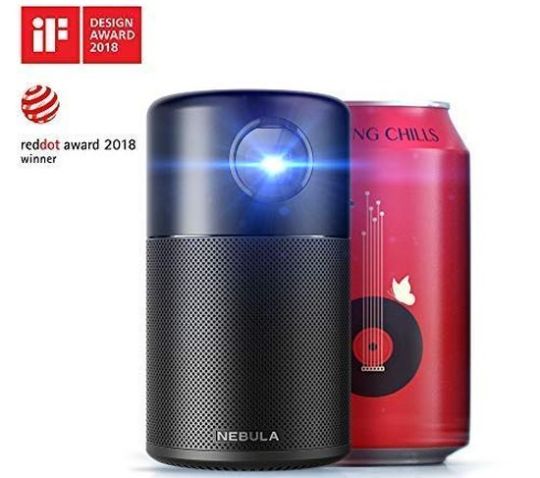
This Smart Model uses Android 7.1 and supports Miracast, Streaming Apps, etc. Unfortunately, the brightness of 100 ANSI lm at 854 x 480 resolution with contrast of 400:1 (full on/off) correspond only to the average level in this segment. The projector's Throw Ratio is 1.30: 1 (D: W). The projection calculator from the authoritative https://www.projectorcentral.com shows 40"@45 inch at Recommended image brightness 59 nits for rooms with low ambient light at Screen Gain of 1,2. But, according to the company, advanced DLP IntelliBright algorithms provide sufficient clarity, contrast, saturation and brightness of the image with a screen diagonal up to 100" at low ambient light. In particular, the company indicates Throw Ratio of 100"@3.08 m; 80"@2.46 m; 60"@1.73 m; 40"@1.15 m. But image with a screen diagonal 50" and more may be too dim. Of course, light-absorbing panels on the walls and a special screen with a high Screen Gain partially solve this problem. A powerful 5.0 W omnidirectional speaker provides sound in all directions.
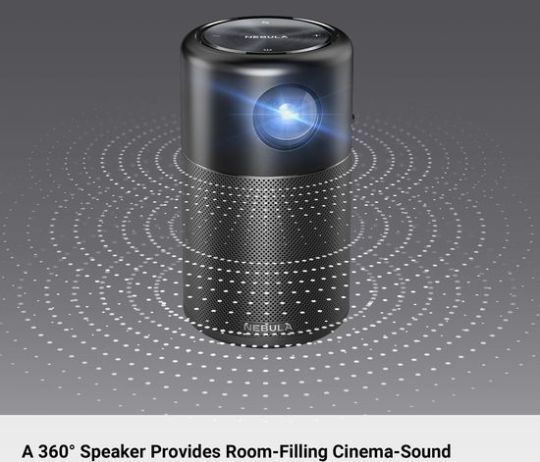
In addition, the model provides Auto Keystone Correction (vertical ± 40 °). With a price of only $ 300, high image quality, omnidirectional sound, Android 7.1 OS, Soda-Can Design, 4-hour continuous video playback and wide connectivity allow it to be present in the top lists of many experts.
Anker Nebula Capsule II DLP projector
Already in March 2019, the company first proposed on the Amazon Anker Nebula Capsule II projector, which belongs to a higher class.
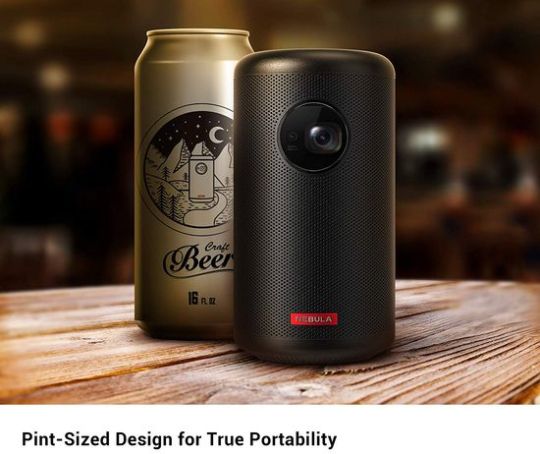
This model provides brightness of 200 ANSI lm at 1280 x 720 resolution with contrast of 1,000: 1 (full on / off). Furthermore, the new projector uses improved 0.3-in HD DLP instead of 0.2-in FWVGA DLP Display Technology. In addition, unlike the manual focus adjustment in the previous model, this projector provides 1-second autofocus. Moreover, Anker Nebula Capsule II uses the more powerful 1 × 8W (270°) speaker.
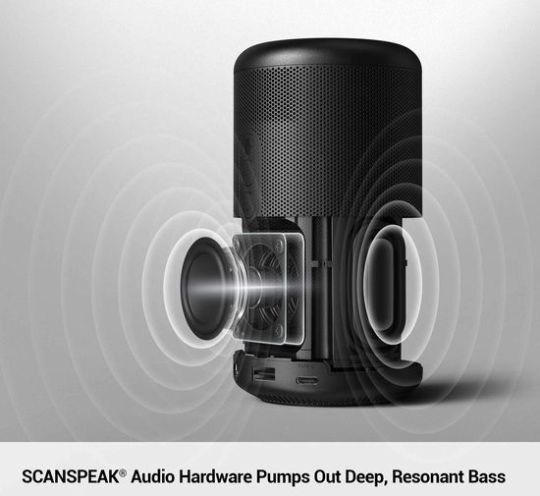
Additionally, the model runs on Android TV 9.0 and supports Google Assistant and Chromecast. Throw Ratio and Auto Keystone Correction have not changed. Unfortunately, a significant improvement in specs predictably increased its size (height of 5.9 vs 4.72 in and diameter of 3.14 vs 2.67 in), weight (1.62 vs 1.0 lbs) and price ($ 580 vs $ 300). In addition, the model provides only 2.5-hour continuous video playback vs 4-hour in Nebula Capsule. On the other hand, this projector provides Supper-Fast Charging with UCB-C Power Delivery Technology (2.5 hrs only).
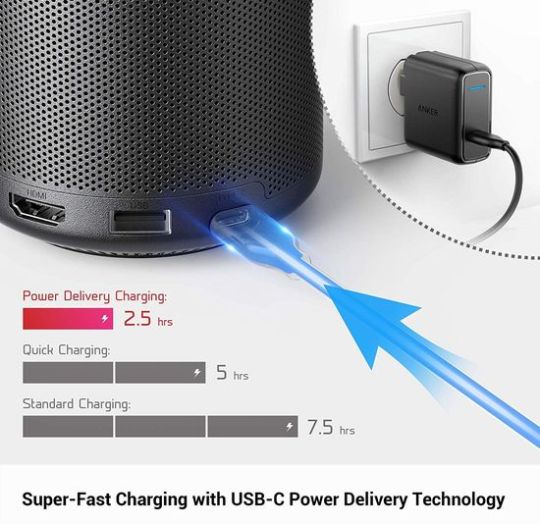
Anker Nebula Mars Lite and Nebula Mars II
In the spring of 2018, the company introduced Nebula Mars Lite and Nebula Mars II. They have the same design, size and weight (14 cm x 12 cm x 18 cm and 3.3 lbs).
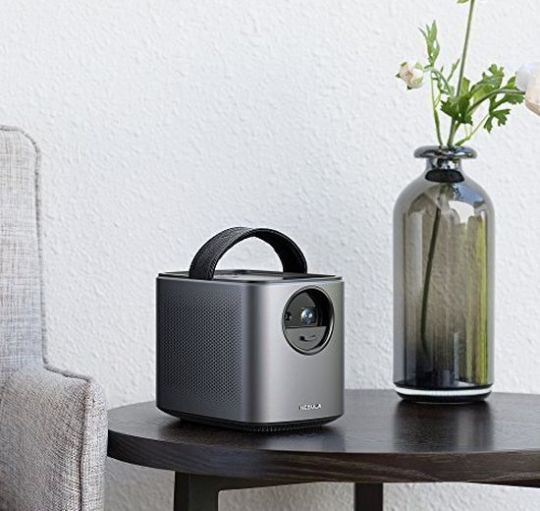
Both projectors provide brightness of 300 ANSI Lm at 1280 x 720 (16:9, HD) resolution with contrast of 1,000:1 (full on/off). In addition, they have powerful 10.0 W × 2 speakers.
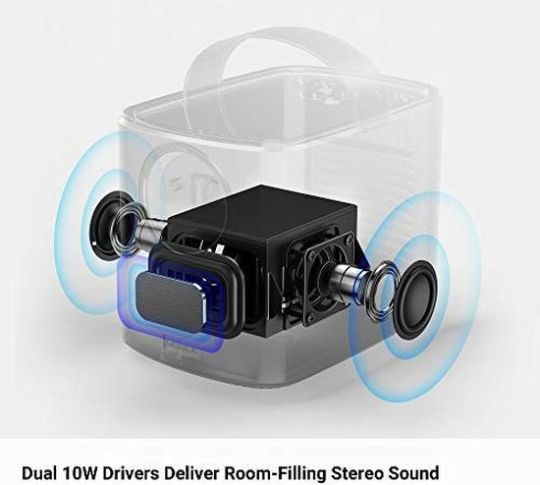
According to the company, their Throw Ratio (1.20:1(D:W)) includes: 100" @3.08 m; 80" @2.46 m; 60" @1.73 m; 40" @1.15 m. On the other hand, the company indicates a range Projection Size 30 -150 in, but warns that 150" is the maximum picture size and will only be clear and saturated in very low-lighting. Both models provide Single-second autofocus and Auto Keystone Correction (vertical ±40°). Nebula Mars II is a smart model (Android 7.1) and supports Miracast, Streaming Apps, etc. In addition, Video Playtime of Mars II reaches 4 hours vs 3 hours for Mars Lite. In fact, these differences are the only ones. Nebula Mars II costs $ 500 vs $ 350 for Nebula Mars Lite. Thus, today the company offers 4 models with a brightness of 100 to 300 ANSI Lm, a resolution of 854 x 480 or 1280 × 720 at a price of $ 300 to $ 500, which fully ensures the choice of the optimal model. This video illustrates the capabilities of the Anker Nebula Mars II. Read the full article
#0.2-inFWVGADLPDisplayTechnology#Android7.1#AndroidTV9.0#AnkerNebulaCapsule#AnkerNebulaCapsuleII#AnkerNebulaMarsII#AnkerNebulaMarsLite#AnkerNebulaprojectors#auto-keystonecorrection#Pint-SizedDesign#Single-secondautofocus#Soda-CanDesign#Supper-FastCharging#UCB-CPowerDeliveryTechnology
0 notes
Text
Projector Features
Tough competition in the consumer electronics segment encourages companies to constantly improve their devices. A few decades ago, competitiveness largely depended on the price and quality of the model. Of course, today the price remains the main selection criterion. But the quality situation has changed significantly. As a rule, modern models even of budget level from well-known companies have high quality of materials and assembly. Their further increase demands essential expenses which negatively influence competitiveness. Thus, this resource is almost exhausted. On the other hand, the rapid development of digital technologies has dramatically expanded the innovative possibilities for the development of modern household appliances. Of course, the digital innovations expand their functionality, enhancing consumer properties of any device. As a result, the competitiveness of modern models mainly depends on the price and functionality with necessarily high quality. Of course, the development in projectors segment also corresponds to this trend. Accordingly, their functionality directly affects the choice of the optimal model.
Projector Features
- on-screen menu and a remote control; - image inversion horizontally and vertically for translucent or transparent screens and ceiling mount; - adjusting the colors, brightness, contrast and image clarity; - 3D; - interactive mode; - adjustment to the parameters of the input signal; - infrared screen mouse; - correction of image trapezoidal distortion; - choice of menu language; - economy mode with reduced brightness by 15-20% increases lamp life by 1.5-2 times; - interchangeable lenses to change throw ratio; - auto-tuning of the image and auto-keystone correction; - “Off and go” function to quickly turn off the power supply; - freeze frame; - zooming the selected part of the image; - PIP (picture-in-picture) function for simultaneous display of images from two independent sources; - Lens Shift horizontally and vertically simplifies the installation of the projector; - A / V MUTE function; - curtain function opens / closes part of the image; - WiFi support; - IRIS function - automatic adjustment of the image brightness depending on the illumination of the room; - automatic control of the fan operation mode depending on the ambient temperature; - support for DVT and HDTV standards; - choice of image format (4: 3 or 16: 9); - memorization of the projector settings for a large number of signal sources; - network hub to connect to the local network; - systems of protection against thefts and unauthorized use; - auto-backlit keys; - network capabilities (network control, built-in browser, e-mail client, etc.); - custom modes.
Classification
In terms of weight, size and brightness, modern models are conventionally divided into several types: - stationary - more than 40 lb; - portable - 10-40 lb; - ultra portable - 5-10 lb; - micro portable - less than 5 lb; - Palm class - less than 3 lb; - Pico class - less than 1.1 lb; brightness 150 ANSI Lm; - Pocket class - less than 1.0 lb; brightness 7-10 ANSI Lm. But companies are not very strictly adhere to this classification. Pico and Pocket use semiconductor light sources (LEDs or LED lasers) and batteries. Usually, LEDs models provide in a darkened room acceptable image quality with a diagonal up to 20-25 inches. Today, some companies already offer smartphones with a projector option. For example, in 2019, Blackview introduced its new model, the Blackview MAX 1 Projector Mobile Phone. Today, it claims to be a leader among models with a projector function. This smartphone uses Samsung AMOLED display 6.01 inch (2160 x 1080 Pixel), Android 8.1 OS, 6GB RAM, 64GB ROM, 4680mAh battery, CPU MT6763T Octa Core (2.5GHz, 64bit), etc. Its projector is capable of project a 70-inch screen from a distance of 6,6 ft or a 200-inch screen from a distance of 9,8 ft. But, of course, its brightness is much less compared to full-sized projectors. This video demonstrates the Blackview MAX 1 Projector Mobile Phone with Samsung AMOLED display 6.01 inch (2160 x 1080 Pixel), Android 8.1 OS, 6GB RAM, 64GB ROM, 4680mAh battery, CPU MT6763T Octa Core (2.5GHz, 64bit), etc. Read the full article
#3Dprojectors#auto-keystonecorrection#BlackviewMAX1ProjectorMobilePhone#IRISprojectoroption#LensShift#Palmprojector#Picoprojector#PIP(picture-in-picture)projectoroption#Pocketprojector#ProjectorFeatures
0 notes